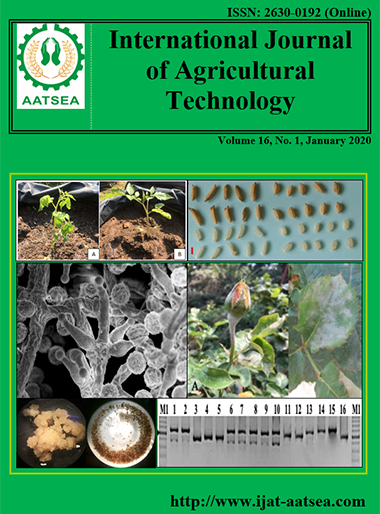Improving photoperiod insensitivity of a Thai upland rice variety by marker-assisted foreground selection
Main Article Content
Abstract
Global warming might increase climate variability with abnormal rainfall distributions. Photoperiod insensitive upland rice can be grown early or late in the rainy season, and to help the stabilize upland rice yields and reduce the risks to farmers. The SSR marker-assisted backcrossing method was applied to breed photoperiod insensitivity into the Thai superior upland rice variety cv. Dawk Pa-yawm as the recurrent parent. The donor parent was photoperiod insensitive Taichung 65, a japonica variety. The photoperiod insensitivity gene hd1 was identified using the RM8225 marker in seedling stage of F1, BC1F1, BC2F1 and BC2F2 plants. The photoperiod insensitive BC2F2 plants that flowered were selected during long day length. The results demonstrated successful use of genetic markers to alter the photoperiod insensitivity trait of an elite rice variety.
Article Details

This work is licensed under a Creative Commons Attribution-NonCommercial-NoDerivatives 4.0 International License.
References
Alam, M. S., Salim, M., Moniruzzaman, M., Rashid, J. A. and Islam, M. M. (2012). Marker-assisted foreground selection fori of salt tolerant rice genotypes. The Agriculturists, 10:1-8.
Allard, R. W. (1960). Principles of Plant Breeding. John Wiley & Sons, Inc., New York, pp.156-158.
Chen, S. X., Lin, H., Xu, C. G. and Zhang, Q. (2000). Improvement of bacterial blight resistance of ‘Minghui 63’, an elite restorer line of hybrid rice, by molecular marker-assisted selection. Crop Science, 40:239-244.
Collard, B. C. Y. and Mackill, D. J. (2007). Marker-assisted selection: an approach for precision plant breeding in the twenty-first century. Philosophical Transactions of the Royal Society B Biological Sciences, 363:557-572.
Dellporta, S. L., Wood, J. and Hicks, J. B. (1983). A plant DNA minipreparation: Version ІІ. Plant Molecular Biology Reporter, 1:19-21.
Dowdy, S., Weardon, S. and Chilko, D. (2003). Statistics for Research. John Wiley & Sons, Inc., Hoboken, New Jersey, pp.98-137.
Feng, X., Wang, C., Nan, J., Zhang, X., Wang, R., Jiang, G. and Yuan, Q. (2017). Updating the elite rice variety Kongyu 131 by improving the Gn1a locus. Rice, 10:1-11.
Hasan, M. M., Rafii, M. Y., Ismaila, M. R., Mahmoodc, M., Rahimd, H. A., Alama, Md. A., Ashkanib, S., Malekf, Md. A. and Latif, M. A. (2015). Marker-assisted backcrossing: a useful method for rice improvement. Biotechnology & Biotechnological Equipment, 29:237-254.
Lewise, R. S., Linger, L. R., Wolff, M. F. and Wernsman, E. A. (2007). The negative influence of Nmediated TMV resistance on yield in tobacco: linkage drag versus pleiotropy. Theoretical and Applied Genetics, 115:169-178.
Lin, H. X., Ashikari, M., Yamanouchi, U., Sasaki, T. and Yano, M. (2002). Identification and characterization of a quantitative trait locus, Hd9, controlling heading date in rice. Breeding Science, 52:35-41.
Lin, H. X., Yamamoto, T., Sasaki, T. and Yano, M. (2000). Characterization and detection of epistatic interactions of 3 QTLs, Hd1, Hd2, and Hd3, controlling heading date in rice using nearly isogenic lines. Theoretical and Applied Genetics, 101:1021-1028.
Mendiburu, F. D. and Simon, R. (2007). Agricolae-a free statistical library for agricultural research. Ames, IA: Iowa State University.
McCouch, S. R., Teytelman, L., Xu, Y., et al. (2002). Development and mapping of 2240 new SSR markers for rice (Oryza sativa L.). DNA Research, 9:199-207.
Yamamoto, T., Kuboki, Y., Lin, S. Y., Sasaki, T. and Yano, M. (1998). Fine mapping of quantitative trait loci Hd-1, Hd-2 and Hd-3, controlling heading date of rice, as single Mendelian factors. Theoretical and Applied Genetics, 97:37-44.
Yamamoto, T., Lin, H. X., Sasaki, T. and Yano, M. (2000). Identification of heading date quantitative trait locus Hd6 and characterization of its epistatic interactions with Hd2 in rice using advanced backcross progeny. Genetics, 154:885-891.
Yano, M., Harushima, Y., Nagamura, Y., Kurata, N., Minobe Y. and Sasaki, T. (1997). Identification of quantitative traits loci controlling heading date in rice using a high-density linkage map. Theoretical and Applied Genetics, 95:1025-1032.
Yano, M., Kojima, S., Takahashi, Y., Lin, H. X. and Sasaki, T. (2001). Genetic control of flowering time in rice, a short-day plant. Plant Physiology, 127:1425-1429.
Sangtong, V., Khonkaent, J., Siripoonwiwat, W., Pintanont, P., Watanakawikrant, S., Roongruangsree, N. and Roongruangsree, U. (2007). Inheritance of major gene, Hd1/hd1, in controlling photoperiod sensitivity of BC2F2 and BC2F3 rice plants”, Proceeding of the 2nd International Conference on Rice for the Future, Bangkok, Thailand, pp.413-419.
Sangtong, V., Siripoonwiwat, W., Pintanont, P., Watthakawigran, S., Roongruangsree, N. and Tippitak, S. (2008). Developing markers for using in glutinous rice improvement of RD 6 for non-photoperiod sensitivity by marker-assisted backcrossing. King Mongkut’s Agricultural Journal, 26:96-110.


